All 59 entries tagged Coin Of The Month
No other Warwick Blogs use the tag Coin Of The Month on entries | View entries tagged Coin Of The Month at Technorati | There are no images tagged Coin Of The Month on this blog
August 01, 2018
Fulvia: the power behind the lion?

Fig. 1. Antony, Cisalpine Gaul, Silver Quinarius, c. 43-42 BC, RRC 489/6. (Image © the Trustees of the British Museum).
This is a Roman Republican silver quinarius, dated to 43-42 BC, believed to have been minted in Cisalpine Gaul, and is currently held by the British Museum. It was issued by Mark Antony and its iconography is similar to another coin type referring to Lugdunum.
The reverse of the coin carries the legend “ANTONI IMP XLI”, and this, together with the walking lion provide personal references to Antony. XLI (41) refers to his age, and the lion, a recurrent iconographic emblem on Antony’s coinage, may represent the claim that the Antonii were descendants of Hercules (see Plutarch, Life of Antony, 4.1). Plutarch states that Antony believed his physical attributes confirmed this heroic descent, choosing also to attire himself in a manner suggestive of Hercules. Such self-representation would have offered a counter-claim to that of the Julian family’s divine descent from Venus via Aeneas. Plutarch also states that Antony’s excesses ran to excursions in chariots drawn by lions, and this is also attested to by Pliny (Natural History 8.21) who asserts he was the first man to harness lions to his chariot in Rome. Therefore, the depiction of the lion can be read as a means to promote and emphasise both his physical strength and prowess, and also to accentuate his alleged ancestry.
The obverse has a border of dots and an anti-clockwise inscription of III.VIR.R.P.C. which expands to III vir rei publicae constituendae consulari potestate (triumvir for confirming the Republic with consular power) and refers to the second triumvirate formed by Antony, Octavian and Lepidus in 43 BC.
The portrait bust on the obverse is a personification of Victory, signified by the wings at the base of the neck, and convincing arguments exist to suggest that it is a portrayal of Antony’s wife Fulvia. This is partly due to the image’s facial features having more in common with contemporaneous lifelike portraiture than the classicism favoured for deities, and equally the hair is similar in style to what was fashionable at the time, with this particular hairstyle not being featured on other representations of female deities.
Fulvia is a fascinating, albeit not endearing, character. Antony, who she married in 47 or 46 BC, was her third husband – having previously been married to Publius Clodius Pulcher, then Gaius Scribonius Curio – and all three were supporters of Caesar. Literary sources indicate she was highly politically motivated, more so after Caesar’s death, purportedly to promote and protect Antony’s interests while he was in Gaul, becoming powerful and influential in the senate (see Cassius Dio, Roman History, 48.4-10, Appian, Civil Wars, 5.3.19). Appian relates that Fulvia was actively involved in the proscriptions of 43 BC (see Appian, Civil Wars 4.4.29) whilst Cassius Dio condemns her as responsible for many deaths to satisfy her greed for wealth and hatred of certain adversaries – in particular, he recounts her brutal treatment of Cicero’s decapitated head (Cassius Dio, Roman History, 47.8). She was also directly involved in, if not being the cause of the uprising by Antony’s brother Lucius, who was consul in 41 BC, which resulted in his defeat by Octavian at Perusia in Etruria in 40 BC. Fulvia then fled to Greece where she died, having been rebuked by Antony for her involvement in the debacle.
The significance of the amount of power Fulvia wielded is also evidenced by the city Eumenea in Phrygia being renamed Fulvia around 41 BC, where it is believed she was also honoured on coinage, again in the guise of Victory. Equally, as the competition for political dominance between Octavian and Antony is apparent in other coinage, the appearance of Fulvia may have been intended as an important advertisement to convey a widespread political message of strength and unity via their marriage and perhaps even suggesting some dynastic ambition.
It is interesting in comparison, that women connected to Augustus rarely featured in his coinage during the principate, and this may be resultant from a desire to disassociate himself from both Antony’s reputation of being ruled by women (see Plutarch, Antony 10) and his apparent penchant for utilising his wives’ images on coinage – Fulvia was followed by Octavia, whose image was not disguised by deific attributes, and then Cleopatra, who he is thought to have married around 37 BC, (although this marriage was not valid in Rome). Additionally, Augustus’ own personal experience of Fulvia, may also have been influential in his later social reforms and moral legislation in attempting to ensure a higher standard of behaviour for women and a return to more traditional domestic roles.
 |
This month's coin was written by Jacqui Butler. Jacqui has just completed the first year of the MA in Ancient Visual and Material Culture (part time), having gained a BA in Classical Studies with the Open University last year. Her main interests lie in the visual depictions of both mythical and real women in Roman material culture, specifically in art, but also their representation in epigraphy on funerary monuments.
Bibliography
Bauman, R.A. (1994) Women and Politics in Ancient Rome (London, Routledge).
Fraschetti, A. (2001) Roman Women (London, The University of Chicago Press). Kleiner, D.E.E (1992) “Politics and Gender in the Pictorial Propaganda of Antony and Octavian”, Echos du monde classique: Classical views, Volume XXXVI, n.s. 11, Number 3, 1992, pp. 357-367.
MacLachlan, B. (2013) Women in Ancient Rome, A Sourcebook (London, Bloomsbury Academic).
Rowan, C. (forthcoming) ANS/CUP Handbook to the Coinage of the Ancient World 49 BC – AD 14. (Cambridge, Cambridge University Press).
Wood, S.E. ( 2001) Imperial Women, A Study in Public Images, 40 BC – AD68 (Mnemosyne, bibliotheca classica Batava, Supplementum 195).
July 01, 2018
Augustus and the Exaggeration of Military Victories

Figure 1: Figure 1: Gold Aureus from the reign of Augustus, 19-18 BC (RIC I (second edition) Augustus 514). The obverse depicts the head of Augustus, with ‘AVGUSTVS’ inscribed (not visible on this specimen). On the reverse is the deity Victory cutting the throat of a bull, representing Armenia. The reverse legend reads ‘ARMENIA CAPTA’. Image produced courtesy of the Trustees of the British Museum.
This coin is indicative of Augustan propaganda, where Augustus exaggerates the role of the military in dealings with Armenia. The Roman Empire and the Parthian Empire were in constant dispute over Armenia, which acted as a buffer zone between the two empires in the East in the first century BC. Armenia fell under Roman influence as a result of treaties and the installation of a pro-Roman ruler, not military annexation. Thus the portrayal of the deity Victory slaughtering a bull (presumably representing Armenia) paints a false militarised narrative of events. The question is why Augustus, on this aureus dating from 19-18 BC, would want to exaggerate his dealings with the Armenians.
It is my belief that this false depiction is an attempt by Augustus to link himself with the military and military success, both key factors in obtaining popularity and support in Ancient Rome. Augustus tries to ‘piggyback’ off the popularity of the army in order to consolidate power; he wishes to be seen as a military man in an attempt to secure his longevity. The military’s popularity stems from the role they played in achieving and maintaining the Empire alongside their connection to the beginnings of Rome, explored by Virgil’s Aeneid. Augustus’ own position was extremely fragile due to the unprecedented nature of his Principate and the real threat of civil war occurring again; he thus sought avenues of popular support. The term ‘capta’ indicates military success, suggesting that the entire state was captured and subjugated, yet this is wholly false. Augustus later on in his own autobiography, Res Gestae (27), even admits this, stating ‘though I might have made it a province’ and details installing a Pro-Roman ruler, further highlighting the degree of exaggeration on the aureus.
The history between Rome and Armenia is particularly key in deciphering why Augustus would exaggerate Rome’s dealings with the Eastern state. Due to Armenia constantly being fought over by Rome and Parthia, it was as a prize for Augustus, that he could claim displayed not only the strength of the Roman military, but his own. Augustus, by portraying himself on the obverse is clearly taking credit for dealings in Armenia, emphasising his role in proceedings, echoed by the inclusion of the Armenia episode in his Res Gestae. One reason why Augustus would particularly emphasise any dealings with Armenia would be to show victory against Roman enemies, the Parthians. The Parthians humiliated Rome with the annihilation of Crassus’ army and loss of the famous legionary standards in 53 BC. This would still be fresh in Roman minds. Augustus’s return of Armenia and later the standards would boost his popularity. Augustus portrayed himself as correcting the wrongs that the Republic never could, cementing his position of singular rule.
This aureus indicates the usage of coinage to foster support and is a prime example of Augustan propaganda through exaggeration of militarism. Both the military popularity and Parthian context are key motivators for Augustus’ actions. The use of this coin to promote popularity indicates that coins were not simply economical tools but key in spreading the Imperial view. This work is based on the view of an imperially directed die-engraver, rather than a die engraver creating something to his own taste.

This month's coin was written by Dillon Kylan Patel. Dillon is an undergraduate first year Ancient History and Classical Archaeology student and current Secretary of Classics Society with a keen interest in Numismatics, especially in the Imperial period. This summer I’ve been luckily enough to gain a placement at the British Museum where I will further explore numismatics.
Bibliography
Bellinger, A & Berlincourt, M (1962) ‘Victory as a coin type’, Numismatic Notes and Monographs 149:1-68.
Edwell, P. (2008) Between Rome and Persia (London: Routledge).
Gow, J. (1895) ‘Horatiana’. The Classical Review 9:6:301-304.
Res Gestae Divi Augusti, trans Shipley, F.W (New York/ London: Harvard University Press 1924).
June 01, 2018
A Roman Token Mould in Harvard
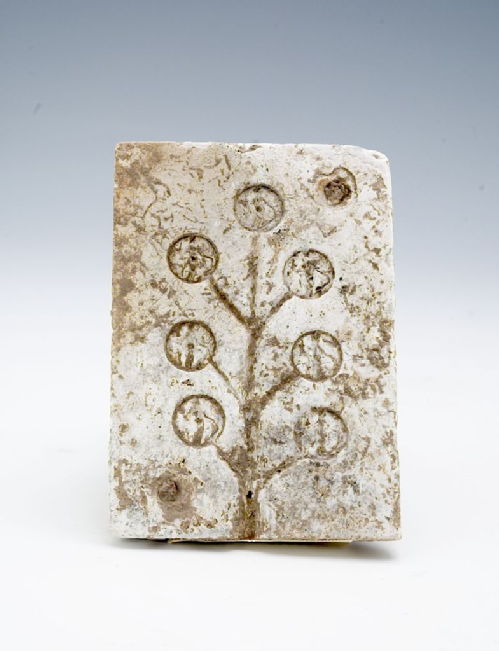 |
| Roman Token Mould from Harvard Art Museums, 2008.118 |
Amongst the McDaniel bequest to Harvard Art Museums in Boston is one half of a mould made of palombino marble. Shown here, this piece is one of the numerous moulds of this type used to cast Roman lead tokens. This particular mould half is 10.8x7.6x2.9cm and weighs 389.2g. It would have been used in conjunction with another half to cast seven circular lead tokens of c. 14mm, all carrying an image of the goddess Fortuna holding a cornucopia and rudder (and presumably another image on the other side, engraved on the other half of the mould). It has previously been published in Hirschland and Hammond 1968.
This type of token mould is characteristic of Rome and Ostia, and was donated to Harvard along with McDaniel's collection of Roman lead tokens and other antiquities. We know from McDaniel himself that he purchased his lead tokens (and thus probably also this mould) from the city of Rome. In his memoir, Riding a Hobby in the Classical Lands (p. 71), McDaniel writes:
“For the integrity of one dealer in Rome I can vouch unreservedly and so, as a contrast to some of the rest of my group, I name him here at the end of the chapter, honoris causa, Signore Scalco. His sunny face and smile alone used to lighten the tiny, gloomy shop not far from St. Peter’s in which he exposed for sale his modest stock of classical antiquities. A charming, well-informed Italian was he, who often had unusual things for sale. Thus, it was from him I bought a considerable number of papal medals…. From him, too, came my piombi, those coin-shapes of lead which have so much about them to pique the curiosity and to puzzle the best of scholars as they work on the problem of their various uses. While I almost never saw any customers in the shops of the other small dealers in Rome, Scalco was one who received calls from archaeologists, who liked to chat with him, and also from the proprietors of the more pretentious establishments, who would buy from him in order to sell again. There, too, one might chance at any time upon one of the rough dwellers of the Trastevere who had fished something out of the Tiber which he expected to have identified as modern, or, if good luck were his, to sell as an antiquity. He was just as sure as the most promising customer to receive all the attentions of courtesy and fair treatment; that was Scalco."
 |
|
Cast lead tokens
from Ostia.
|
The mould carries the channels through which molten lead was poured into the token cavaties; the resulting tokens were then broken off to be used (see the picture left for an example of what the resulting cast would have looked like before the tokens were broken off). The mould still contains the iron nails used to fasten both halves of the mould together (in the top right and lower left corners) - this would ensure that both halves of the mould were correctly aligned. The top and bottom sides of the mould carry faint grooves (see image below); it has been suggested that these grooves were created for or by wire that was wrapped around the moulds during the casting process (Pardini et al 2016). The back of the mould is unworked, as many moulds of this type are.
The top right corner of the Harvard mould has an unusual feature: two concentric circles are etched into the material (see image below). The inner circle is 14mm, the precise diameter of the tokens produced by this mould. These two circles may have been an error made by the person producing the mould, or they may in fact provide a clue as to how these moulds were made: perhaps two concentric circles were sketched before a design was carved into the inner circle- here, perhaps, it was decided that this additional token design was not needed. When one looks closely at each of the circular designs, one sees a deep circular depression at the centre, on Fortuna's body. Jack Kroll, in his unpublished catalogue of these pieces, suggested that this depression was caused by the bit of an instrument used for cutting the circular depressions before the designs were engraved (much like the point of a compass). Many Roman lead tokens carry circular protuberances at their centre; the Harvard mould allows us to understand these protuberances were the result of the mould manufacturing process rather than an intentional part of the design.
Images below from left to right: the side of the mould with faint grooves; a close up of the top left corner of the mould showing two concentric circles and a central depression on the body of Fortuna; a Roman lead token from the Harvard Art Museums collection (2008.116.41) with a wreath and a central dot, now understood to be a result of the mould making process.
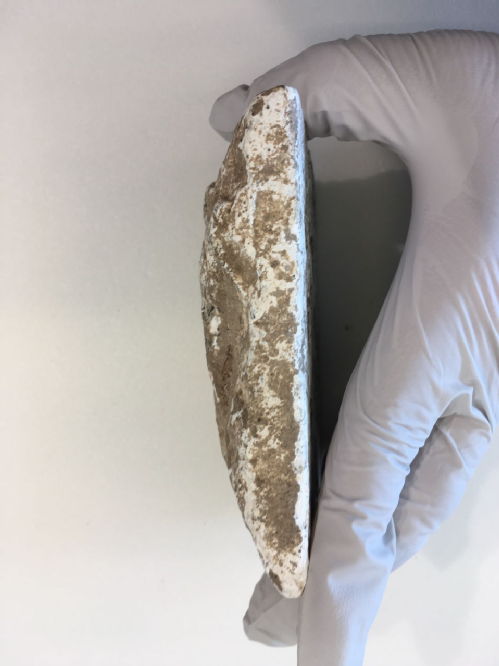 |
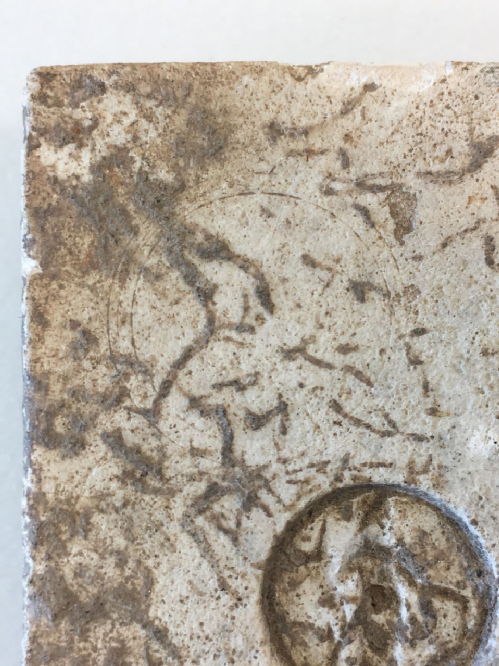 |
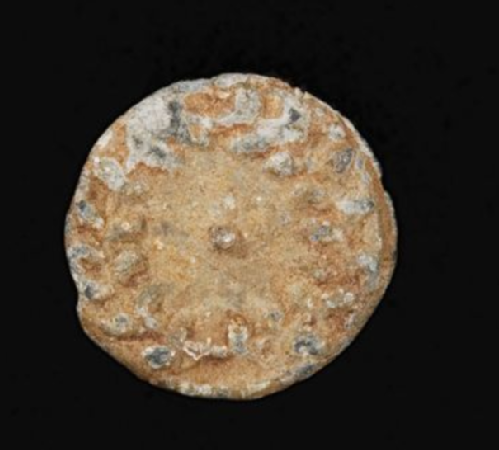 |
This coin of the month was written by Clare Rowan as part of the Token Communities in the Ancient Mediterranean Project.
Select Bibliography:
Hirschland, N. L. and M. Hammond (1968). Stamped Potters' marks and other stamped pottery in the McDaniel Collection. Harvard Studies in Classical Philology 72: 369-382.
Kroll, J. H. (unpublished manuscript). Roman Lead Tokens in Harvard Art Museums.
McDaniel, W. B. (1971). Riding a Hobby in the Classical lands. Cambridge, Mass., Harvard University Printing Office.
Pardini, G., M. Piacentini, A. C. Felici, M. L. Santarelli and S. Santucci (2016). Matrici per tessere plumbee dalle pendici nord-orientali del Palatino. Nota preliminare. In: Le regole del gioco tracce archeologi racconti. Studi in onore di Clementina Panella. ed. A. F. Ferrandes and G. Pardini, Edizioni Quasar: 649-667.
May 01, 2018
Tokens for the Eleusinian Mysteries
The intersection of imagery between tokens and coins in Hellenistic Athens remains an understudied phenomenon. It has previously been thought that tokens functioned as substitute for coinage or as an alternative currency according to a ‘functional’ approach. A more semiotic approach to these objects has underlined the obvious verisimilitude of Hellenistic tokens to the moneyer’s symbols of Athenian New Style coinage, identifying the common imagery used by a wide set of media, which included tokens, coins, weights and measures, as well as bronze allotment plates (pinakia).

Athenian lead token from Göttingen with a poppy head between two ears of wheat. (Göttingen, As-Pb-085, 13mm)
A token, shown above, struck only on one side with a poppy head between two ears of wheat and recently studied in the University Museum of Göttingen, returns to this question. The type follows closely coin types of the 70s BC. (J.H. Kroll with contributions by A.S. Walker, The Greek Coins, The Athenian Agora, vol. 26, Princeton: American School of Classical Studies at Athens, 1993, 118; 133-134). It is very probable that two different but closely associated workshops prepared two distinct sets of dies. The fact that dies for tokens have to date never been found, in conjunction with the evidence that indicates a continuous circle of disposing of the old tokens and recycling them, points to the fact the polis carefully controlled the production of tokens.
Tokens gave access to a broad array of state pay: for example assembly pay, misthos ekklesiastikos, from the late 5th cent. BC, juror’s pay from the late 5th century BC onwards, theatre tickets paid out on an ad hoc basis from the late 5th century BC, and regularly from the theorikon fund from the middle of the 4th century BC. Fraudulent behaviour then is likely to have been quite common. In fact it is impossible to know how many, if any, of the tokens surviving today are ancient counterfeits.
Among the tokens with ‘coin imagery’ a particular group stands apart. These are the tokens that fully copy or closely follow the imagery of Eleusinian coinage, struck in the name of Eleusis and likely connected to festivals. The ‘poppy-ear wheat token’ is one of them. But the ‘kernos’ or ‘plemochoe’, a type of vessel, is a far more popular ‘Eleusinian’ device on tokens.
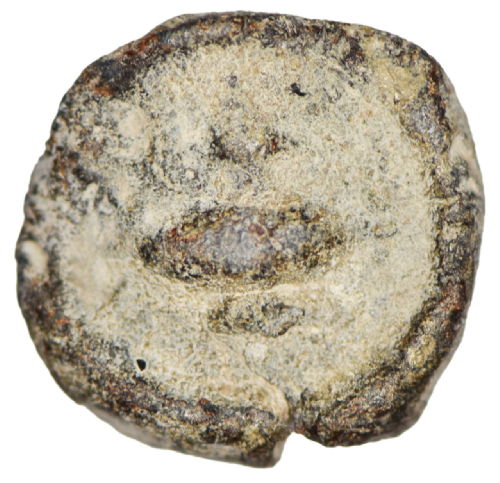 |
 |
|
Token showing a kernos.
Göttingen, AS-Pb-090, 12mm
|
Token showing a kernos.
Göttingen, As-Pb-091, 11mm
|
Two such tokens showing a kernos are also found in the University Coin Collection of Göttingen, shown above. Remarkable also is a bronze token with a kernos on the reverse, accompanied by the legend ΔΗΜΟΣ ΑΘΗΝΑΙΩΝ, ‘the demos of Athens’ (Svoronos 1898, 124). The vessel is also attested as a countermark on a lead token of the letter series (Crosby 1964, L5). The kernos appears for the first time on Athenian bronze coinage (hemiobols and chalkoi) of the period following the evacuation of the Macedonian garrisons from the forts of Attica in 229BC.
The last day of the Eleusinian Mysteries was called ‘Plemochoai’, named after these particular vases, which were used ceremonially. A. Dumont has suggested that tokens carrying these designs could have been used in the Eleusinian Festival. The circumstances could have been similar to the ones that prompted the ‘ΕΛΕΥΣΙ coinage’, the coins carrying a reference to Eleusis. Perhaps tokens were employed as credit when the appropriate money was not available. Or – more probably – tokens were issued by the Boule and the magistrates responsible for the Eleusinian Mysteries or the panegyriarch, who presided over the panegyris (assembly) related to the festival. Today ‘kernos-tokens’ have been found in and around the tholos of the Agora in Athens.
The connection of tokens to Athenian Festivals in the Hellenistic Period is also attested through another important find: all the ‘Panathenaic Amphora – tokens’ have been found very near the so-called Arsenal, on the North side of the Agora, the only building which contained sherds of Panathenaic Amphoras.
This month's entry was written by Mairi Gkikaki as part of the Token Communities in the Ancient Mediterranean Project.
Bibliography
W. Bubelis, ‘Tokens and Imitation in Ancient Athens’, Marburger Beiträge zur Antiken Handels-, Sozial- und Wirtschaftsgeschichte 28, 2011, pp. 171-195.
Fr. De Callataÿ, ‘Les Plombes à type Monétaires en Grѐce Ancienne: Monnaies (officielles, votives ou contrefaites), jetons, sceax, poids, épreuves ou fantaisies?’ RN 167, 2010 pp. 219-255.
M. Crosby, ‘Lead and Clay Tokens. Part II’, in Lang, M. Crosby, M., Weights, Measures and Tokens. The Athenian Agora, vol. 10 (Princeton: American School of Classical Studies at Athens, 1964).
L. Deubner, Attische Feste (Berlin 1932).
A. Dumont, De Plumbeis apud Graecos Tesseris (Paris 1870).
M. Gkikaki, 'The Collection of Athenian Lead Tokens at the University Museum of Göttingen' (SchwNumRu forthcoming)
J.H. Kroll with contributions by A.S. Walker, The Greek Coins, The Athenian Agora, vol. 26 (Princeton: American School of Classical Studies at Athens, 1993).
C. Mann, Spent or Saved? The Circulation of Festival Coins Struck for the Eleusinian Mysteries, Unpublished MA Essay (University of Warwick 2017, RNS Parkes Weber Prize)
G.E. Mylonas, Eleusis and the Eleusinian Mysteries (Princeton 1961).
M.P. Nilsson, Die Geschichte der Griechischen Religion (München 1941).
P.J. Rhodes, The Athenian Boule (Oxford 1972).
I.N. Svoronos, ‘Περί των Εισιτηρίων των Αρχαίων. Μέρος Α΄ Εισιτήρια του Λυκούργειου Διονυσιακού Θεάτρου και της Κλεισθενείου Εκκλησίας των Αθηναίων’. JIAN 1, 1898, pp. 37-84.
April 01, 2018
Tessera hospitalis: a gift for your guests
 |
|
Fig. 1: A drawing representing
the concept of hospitality.
(Tomasini 1670: 133).
|
“Hospitality” was worthy of high, valuable consideration in the Greek and Roman world. It is not a coincidence that Zeus Xenios was the powerful protector of guests. The Greek word for hospitality was xenia, while the Romans called it hospitalitas. This concept was strongly sincere and implied a true friendship between the host and the guest. The latter could be a friend or a relative, who came to his host’s house for a brief or long period of time (fig. 1). Moreover, hospitality was considered a sacred institution. It was therefore based on serious rules and rituals. First, the host had to accommodate the guest respectfully. Second, the guest had to esteem his host, being kind and gracious while he was staying at his house. Third, hospitality established a mutual exchange of favours, reciprocal esteem and a series of gifts. Among them, the host could donate a tessera hospitalis (token of hospitality) to his guest.
This ‘ad hoc’ gift was prepared and personalised every time to testify that the hospitality was successful and to strengthen the bond between the guest and the host. We even know that the tessera might be broken in two parts, one for the guest and one for the host. Considering how heart-felt and widespread the concept of hospitality was, it is quite surprising that these artefacts seem to be quite rare nowadays. Two such objects are currently preserved at the Archaeological Museum of Madrid (1st century BC) (Saquette 1997: 420, n. 238) and the Museum ‘B. Anselmi’ in Marsala (Trapani – Sicily), ancient Lilybaeum (Trapani – Sicily) (2nd-1st century BC) (Salinas 1873: 53).
A third tessera (fig. 2) found at Trasacco (Aquila) (fig. 3) in 1895, is now stored at the National Museum of Rome. Dated to the 2nd century BC, the artefact was published by Felice Barnabei (1842-1922), a well-known archaeologist and General Director of Antiquities and Fine Arts (1896-1900), who wrote a detailed paper in the Notizie degli Scavi di Antichità (Barnabei 1895: 85-93; Letta 2001: 152; Luschi 2008: 137-86). The tessera is curiously shaped as a ram’s head and carries the following Latin legend, testifying a mutual hospitality between T. Manlius and T. Staiodius:
T(itus)·Manlius·T(iti)·f(ilius)
hospes
T(itus)·Staiodius·N(umerii)·f(ilius)

Fig. 2: Tessera hospitalis found in Trasacco (Aquila) (Letta 2001: 152).

Fig. 3: Map showing Trasacco and Rome (Google Maps).
Antiquarians have been interested in tesserae hospitales since before the 19th century. For instance, Jacopus Philippus Tomasini (1595-1655) (fig. 4), Catholic bishop and learned historian born in Padua, even wrote even an entire book on these artefacts. Published in Amsterdam in 1670 and written in Latin, De tesseris hospitalitatis liber singularis (1670) (fig. 5) is a thorough 230-page essay that signifies Tomasini’s deep knowledge of Greek and Roman history and analyses the concept of hospitality through historical and antiquarian sources (fig. 6).
 |
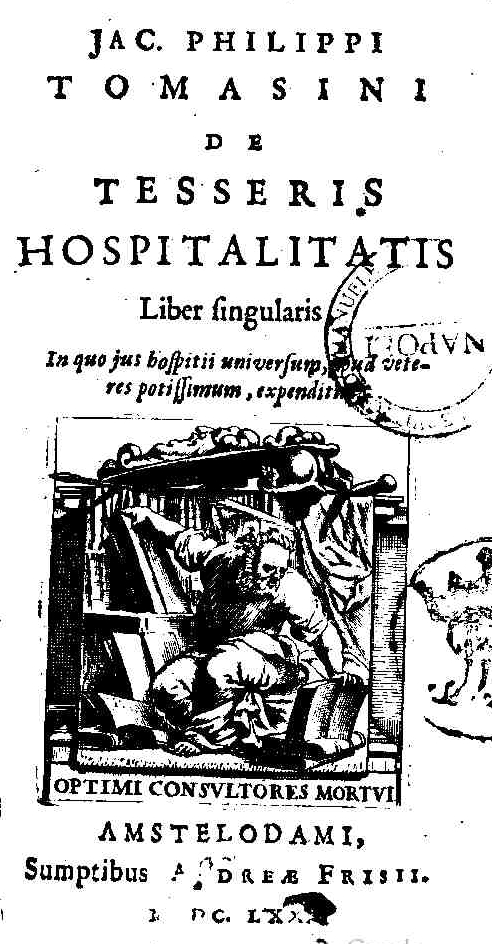 |
|
| Fig. 4: Portrait of Jacopus Philippus Tomasini (1595-1655) (Wikipedia). | Fig. 5: De tesseris hospitalitatis liber singularis by J. P. Tomasini (1670) (online, GoogleBooks). |

Fig. 6: Drawing of a tessera from a private collection (Tomasini 1670: 107)
Why did Tomasini write this work? He began to seriously think about his essay (serio mecum cogitare coepi) when he was in Rome admiring its ruins. Although the concept of hospitality was not ‘directly’ shown by Rome’s major antiquities, a targeted study was lacking and therefore it was essential to collect all the antiquarian and historical evidence (Tomasini 1670: 1-3).
 |
This blog post was written by Nino Crisa as part of the Token Communities in the Ancient Mediterranean Project. Nino is an archaeologist, numismatist and historian. His research and published works mainly focus on numismatics and the history of Sicilian archaeology and excavations, particularly on archival records, antiquarian collecting, the history of museum collections, antiquities safeguarding and legislation on the cultural heritage between the Bourbon and post-Unification periods (1816-1918).
Bibliography:
Barnabei, F. 1895, ‘Di una rarissima “tessera hospitalis” con iscrizione latina’, Notizie degli Scavi di Antichità: 85-93.
Letta, C. 2001, ‘Tessera hospitalis dal territorio di Trasacco’, in A. Campanelli (ed.), Il tesoro del lago. L’archeologia del Fucino e la Collezione Torlonia. Catalogo della mostra, Avezzano, 22 aprile-31 ottobre 2001. Pescara: Soprintendenza Archeologica dell’Abruzzo: 152.
Luschi, L. 2008, ‘L’ariete dei “Manlii”: note su una “tessera hospitalis” dal Fucino’, Studi Classici e Orientali, 54: 137-86.
Salinas, A. 1873, Del Real Museo di Palermo: relazione. Palermo (reported in V. Tusa (ed.) 1976, Scritti scelti, Palermo: Regione Siciliana, I: 240-86).
Saquette, J. C. 1997, ‘Tessera di ospitalità a forma di mano’, in J. Arce, S. Ensoli and E. La Rocca (eds.), Hispania Romana: da terra di conquista a provincia dell’impero. Catalogo della mostra, Roma, Palazzo delle Esposizioni, 22 settembre-23 novembre. Milan: Electa: 420.
Tomasini, J. P. 1670, De tesseris hospitalitatis liber singularis, in quo ius hospitii universum, apud veteres potissimum, expenditur. Amestlodami: Sumptibus Andreae Frisii.
March 01, 2018
The Athenian polis and its 'winged' symbola
In the three centuries between the recovery of Athens after the Peloponnesian War in the 390s and Sullan Sack in 86 BC the polis (city) was regularly minting symbola – the Greek word for tokens – for a variety of purposes. The images these tokens carry shed light on the fabric of Athenian civic life. These devices, dissimilar to the usual repertoire of the small-scale works of art, are peculiar to the polis ideology. Since they are lacking clarifying inscriptions and because they were discontinued in the Imperial Period, their meaning today is even more cryptic.
The roles the Athenian symbola played were very much linked to aspects of polis institutions, and the messages of these tokens were shared by members of a ‘single community of interpretation’. Inspiration was derived from the world of nature and three creatures deserve our attention here: the cicada, the wasp and the locust.
 |
| Athenian token showing a cicada. |
The cicada (Postolacca 1868, 415, which is pictured left) refers to the much celebrated ‘autochthony’: the Athenians were proud that they had always inhabited the same land, and were ‘born out of the land’ (gēgeneis), just like the cicada (Plato, Symposium, 191C). The myth behind the notion was derived from observations of the cicada’s life cycle: the nymphē remained underground until the fully-grown cicadas emerged from the earth. Cicadas were proudly worn by the famed generation of Marathon-fighters (Thucydides 1.6.3) and the cicada was considered a particular sign of patriotism, going as far as to function as a conscious tribute to past generations. Expressions of political conservatism cannot be not excluded if Aristophanes’ brief mentions of the insect are taken into consideration (Equites 1331; Nubes 984).
Beyond this the cicada is inseparable from music. Its song inspired the Greek spirit, who acknowledged that the cicadas had a divine substance. This charming singer was called the ‘nightingale of the muses’, ‘the soothsayer of the Muses’, and a ‘musician like Apollo’. Plato in Phaedrus narrates that cicadas were originally men, who were carried away by the music of the chorus and the flute: ‘they were so struck by the pleasure of it that they sang and sang, forgot to eat and drink and died before they knew it’ and were reborn as cicadas (259b-c). This passion for music makes the cicada the archetype of the polis; a particular lifestyle defined by openness to the word and deriving from trust to the native spirit of its citizens along with liberality and self-determination in private affairs, as it is exhorted in Pericles’ Epitaph (Thucydides 2.39). It cannot escape us that this very passion stands at the roots of the dual principle of ‘gymnastikē for the body, mousikē for the soul’ (Plato, Res Publica, 376C) with mousikē meaning not just education, but a particular form of socialization, indispensable for the formation and functioning of the polis. The cicada, then, becomes Athena’s companion (Anthologia Palatina 6.120.7-8).
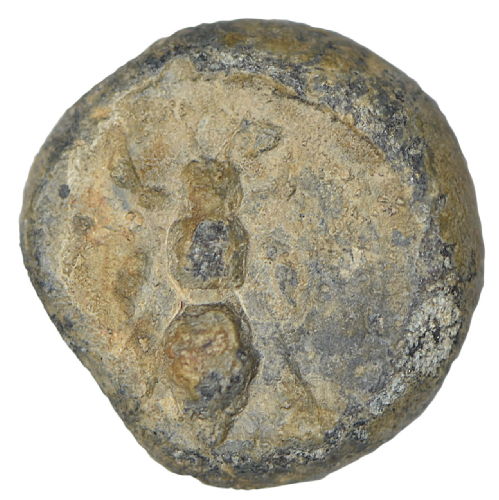 |
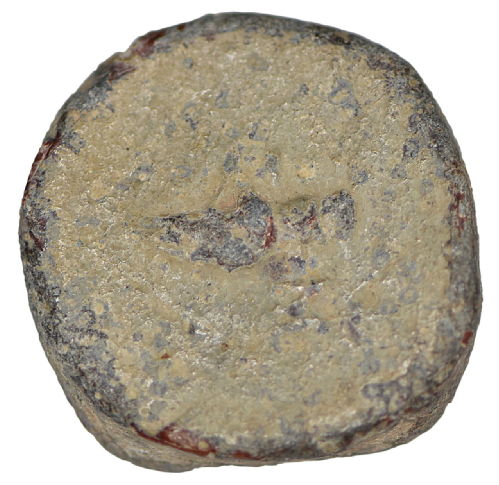 |
| Athenian token showing a wasp. | Athenian token showing a locust. |
If the cicada embodies inherent values of Athenian citizenship, the wasp, also encountered on symbola (University Museum Göttingen AS-Pb-010, 10mm, previously unpublished and shown above), demands an even more challenging approach, especially when considering the apparently harmful nature of the creature. Again here consultation of written sources is indispensable. The wasp stands for anger in Athenian politics, anger resulting from fundamental conflicts in the public forums of debate, which included the Assembly, the Council, and the People’s Courts. Especially through the latter the rebellious anger of the citizen is carefully channelled and finds entrance into the public sphere. As a result the extravagances of elite struggles are tempered and democratic citizenship and the resulting qualification to rule is processed. The litigious wasps ‘have stingers extremely sharp, sticking out from their rumps, that they stab with, and they leap and attack, crackling like sparks’ (Aristophanes, Wasps, 223-27).
A radically different message is conveyed by the locust’s presence on Athenian symbola (shown above, University Museum Göttingen AS-Pb-107, 18 mm, previously unpublished). Given the polis’ constant preoccupation for the safety of the harvest at home on one hand and for ensuring adequate sources of grain from abroad on the other, the locust shouldn’t surprise us. In Hellenistic Athens the loss of the harvest and famine wouldn’t have been the outcome of locust swarms alone, but an event that could also result from long periods of warfare and the ensuing pillaging of the countryside. So it was in the mid-290s BC that the Hellenistic general Demetrius Poliorketes’ 150,000 bushels of grain provided much desired relief after lengthy siege (Plutarch, Demetrius, 34.4). The destructive agent on these symbola, which probably could have been exchanged for wheat, would have signified that the threat had passed and could even have had an apotropaic function.
Sincere thanks are due to Dr. Daniel Graepler, curator of the University Museum Göttingen.
The images were digitally remastered by Matthias Demel.
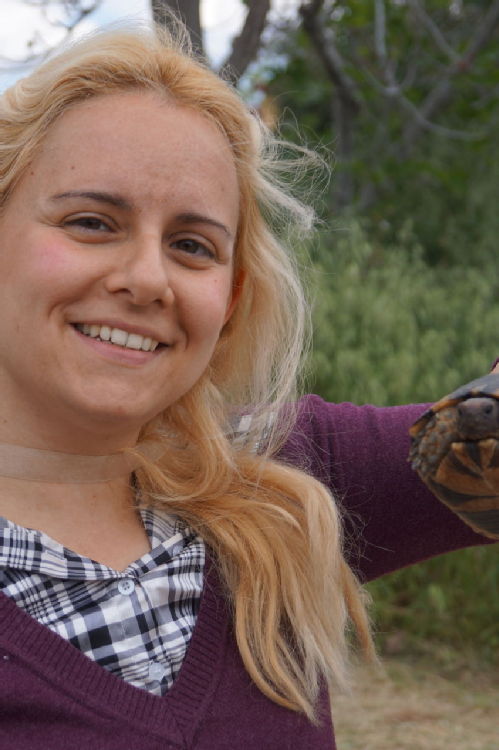 |
This month's coin of the month was written by Mairi Gkikaki as part of the Token Communities in the Ancient Mediterranean Project.
Bibliography:
Bodson, L. (1978). HIERA ZOIA. Contribution a la place de l’animal dans la religion grecque ancienne. Academie Royale de Belgique. Mémoires de la Classe des Lettres LXIII,2: 9-43.
Habicht, Chr. (1997). Athens from Alexander to Antony. Harvard University Press.
Hoffmann, H. (1997). Sotades. Symbols of Immortality on Greek Vases. Oxford: Clarendon Press.
Mabel, L. and Crosby, M. (1964). Weights, Measures and Tokens. The Athenian Agora results of the excavations conducted by the American School of Classical Studies, Volume X: 72-146, pls. 19-32.
Ober, J. (1989). Mass and Elite in Democratic Athens. Rhetoric, Ideology and the power of the people. Princeton University Press: 141-148.
Ober, J. (1998), Political Dissent in Democratic Athens. Intellectual Critics of Popular Rule. Princeton University Press: 46-47.
Oliver, J.G. (2007). War, Food and Politics in Early Hellenistic Athens. Oxford University Press.
Postolacca, A. (1868). Piombi Inediti del Nazionale Museo Numismatico di Atene, Annali dell’ Instituto XL: 268-316 with pl. K; pl. Monumenti Inediti VIII, pl. LII.
Zumbrunnen, J. (2012). Aristophanic Comedy and the Challenge of Democratic Citizenship. Suffolk: Boydell and Brewer: 60-80.
January 01, 2018
The Animal Tokens of Rome
Token are coin-like objects, often made of lead, and interestingly, many examples have been found depicting animals of various species, from lions and elephants, to domestic animals such as horses. Often these items pertain to events organised for entertainment, such as chariot races, hunting, and finally the games themselves, and from studying other depictions of these same animals in Roman art, it becomes clear they may have had a use in these environments.
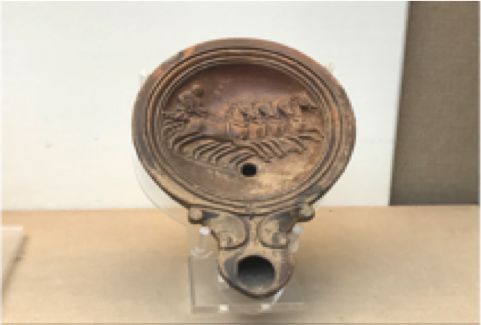 |
 |
|
An oil lamp showing an image of a
charioteer
|
A token from the Ashmolean museum
depicting a charioteer.
|
 |
|
A wax seal, from the British Museum,
depicting a horse and palm branch.
|
Chariot racing was perhaps the most popular sport in the Roman world, as can be seen when Lucian recounts that the “craze for horses is really great, you know, and men with a name for earnestness have caught it in great numbers” (Nigrinus, 29). In Rome, the event was held in the Circus Maximus, which could seat up to 150,000 people, and thus at any given time contain a sixth of the population. Horses feature commonly on tokens in many guises, such showing their domestic function of carrying heavy objects, but also, as seen above, in a more competitive atmosphere of the races. Since such imagery is seen elsewhere, such as an oil lamp, it clearly indicates tokens had a role within the stadia, possibly as entrance tickets for the races. Moreover, some tokens depict horses alongside palm branches. These branches are a symbol of victory, and the very same imagery can be seen on a wax seal from the 1-2nd century AD, also in relation to chariot racing. Thus it could also be suggested that tokens could commemorate a successful day at the races, or have a role in betting. Like today, the Romans would bet on horses, since chariot races involved four different teams, each with their own groups of supporters.
Furthermore, there is also a suggestion that tokens could have had a role in hunting. Hunting had been important in Roman society for centuries, starting as a way to catch food, but later developing into an elite hobby, intended to both train young men for military action, and improve their morality. Some aristocrats had game parks, and there are scenes of the hunt depicted in mosaics, to decorate the domestic space. This indicates how the sport was a popular pastime, and even a status symbol. Some images on tokens are very similar to this mosaic, showing a hunter closing in on a boar, holding his spear aloft. Perhaps therefore, tokens were invites to a hunt, or a commemorative item. This particular image however, could also have come from the games, as boars were hunted both privately, and as part of the entertainment provided in the amphitheatre.
 |
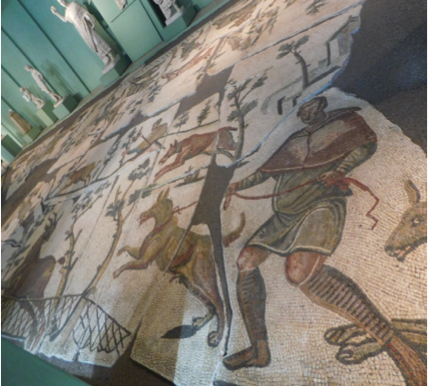 |
| Two scenes from a mosaic which depicts a wild hunt. |
Additionally, the games are perhaps one of the most famous aspects of the Roman world for the modern reader, and their importance can be seen in the way Juvenal suggests all the Roman people wanted was “bread and circuses” (Satires, 10). Alongside the famous gladiators, animal shows, called venationes, were commonly held. During these events, great effort was made to make the colosseum appear like a hunting ground, including the use of scenery, and many animals are recorded as being used, such as big cats, elephants, bears, and herbivores such as boar, deer, and more exotically, zebras. These unfortunate creatures were transported from the conquered provinces, as symbols of Roman superiority over nature, and their empire. Importantly, all these animals can be seen on tokens. Although many tokens are unclear because of the damage they have incurred over the centuries, lions and elephants are instantly recognisable because of their manes and tusks respectively. Elephants were important symbols during the games, and were even depicted coinage. Their size and strength made them signs of the emperor’s might and generosity, thus they became a representation of the games as a whole. Furthermore, lions were commonly used both in the games and images across the Roman world, such as mosaics, where they are seen as vicious, and fearful creatures, who would have been impressive in the amphitheatre. Both these animals therefore hint at the role tokens could have had in the games, again perhaps as a commemorative item.
 |
 |
|
A Roman coin featuring an elephant fighting a big cat in the amphitheatre.
|
A mosaic from Pompeii depicting a lion. |
Perhaps the most illuminating piece of information about the use of tokens in relation to the games comes from literature. Martial tells us “now a large number of tessera allots animals which were watched…now a bird rejoices to fall into a safe lap and is assigned owners by lottery in its absence, to save it from being ripped apart” (Epigrams, 8.78.7-12). This seems to suggest that the meat of the animals would have been distributed to the crowds after the shows, using the tessera, the Latin word for tokens, for ease. Indeed there is no evidence of storage space, or the burial of the dead animals in the colosseum, and while this is disgusting to the modern reader, this practice would have provided a way to both please the populous, and deal with waste. This therefore seems like their most likely use, especially since some tokens do depict birds, as mentioned in the extract.
There are certainly many different examples of animal tokens, and many different possible uses for them, including both practical and commemorative functions. They show how tokens could be closely connected to the world of entertainment, as well as the variety of animals in Roman society.
 |
This month's piece was written by Rebecca Rolfe, a Classical Civilisation with Study in Europe student currently on her year abroad in Italy. She is interested in the importance of iconography in Roman artwork, and the symbolism of images on Roman coins. Over the summer of 2017 Becky conducted research on the animal tokens of Rome with the support of Warwick's Undergraduate Research Support Scheme. As part of her research she translated a segment of Rostovtzeff's Latin catalogue of Roman tokens related to spectacles into English. If you want to learn more about these tokens, the translation is available here!
Bibliography:
Anderson, John Kinloch (1985), Hunting in the Ancient World (Berkley, University of California Press).
Bell, Sinclair and Willekes, Carolyn (2014) ‘Horse Racing and Chariot Racing’, in The Oxford Handbook of Animals in Classical Thought and Life, ed Gordon Lindsay Campbell (Oxford, Oxford University Press) 478-491.
Harrison, George (2001), ‘Martial on Sportula and the Saturnalia’, in Mouseion: Journal of the Classical Association of Canada, Vol 1, No. 3, pages 295-312.
Jennison, George (1937), Animals for Show and Pleasure in Ancient Rome (Manchester, University of Manchester Press).
Kyle, Donald (2007), Sport and Spectacle in the Ancient World (Oxford, Blackwell).
MacKinnon, Michael (2014) ‘Hunting’, in The Oxford Handbook of Animals in Classical Thought and Life, ed Gordon Lindsay Campbell (Oxford,Oxford University Press) 203-216.
Meijer, Fik (2010), Chariot Racing in the Roman Empire (Baltimore, John Hopkins University Press).
Scullard, Howard Hayes (1974), The Elephant in the Greek and Roman World (London, Thames and Hudson).
Shelton, Jo-Ann (2014) ‘Spectacles of Animal Abuse’, in The Oxford Handbook of Animals in Classical Thought and Life, ed Gordon Lindsay Campbell (Oxford, Oxford University Press) 461-478.
Toynbee, Jocelyn (1973), Animals in Roman Life and Art (London, Thames and Hudson).
December 01, 2017
A stater of Stymphalos
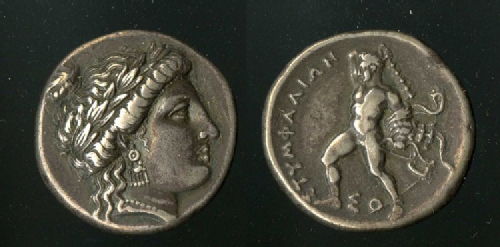 |
| A stater of Stymphalos, © The Trustees of the British Museum |
Obverse: Head of Artemis (?) with laurel wreath.
Reverse: Nude Herakles; ΣΤΥΜΦΑΛΙΩΝ upwards on left, ΣΟ beneath.
Dated mid fourth century BC, diameter 25mm, weight: 11.75g.
Stymphalos was located near the present-day town of Stymfalia, in a mountain valley in north-west Arcadia. In Greek literature, it is famous as the site of the sixth Labour of Herakles – in which he battled the carnivorous Stymphalian birds. The site was first excavated by Anastasios Orlandos during the 1920s. More recently, excavations by the University of British Columbia (led by Prof. Hector Williams) took place between 1994 and 2001. Amongst the finds were a large quantity of coins – 492 in total – yet of this figure, only five of the coins found were minted in Stymphalos itself.
This coin is a silver stater, minted in the mid fourth century BC. On the obverse, we see a bust of a female deity, crowned with a laurel wreath. This has previously been identified as Artemis, due to the archaeological material pertaining to a female goddess at the acropolis sanctuary at Stymphalos. Archaic figurines found in the excavation are seen holding a small animal in one hand – thought to be a hare – an animal often depicted with Artemis. In addition, references attesting the worship of the ‘Braurion Artemis’ at Stymphalos support the view of there being a sanctuary to the goddess. However, votive offerings found at the sanctuary allude to dedications to Eileithyia, and we know from Pausanias that she was worshipped in the region. Coins at Argos have also been found bearing the portrait of Eileithyia, and so it is not unreasonable to suggest that the deity depicted here could be either Eileithyia or Artemis.
The reverse displays a portrait of Herakles in action: with one hand raised, holding a club, and the other with bow and arrow, with the inscription ‘ΣΤΥΜΦΑΛΙΩΝ’ on the left-hand side. The lionskin that he is usually depicted wearing as a headpiece is instead flung around his left arm. This depiction of Herakles differs from other coins minted at Stymphalos (one is pictured below), where he is shown in portrait style, with an image of a Stymphalian bird in profile on the reverse. It would be safe to presume in this instance, that the two images: Herakles and the Stymphalian bird, have been combined in an active portrait showing Herakles in the midst of battle in his sixth labour.
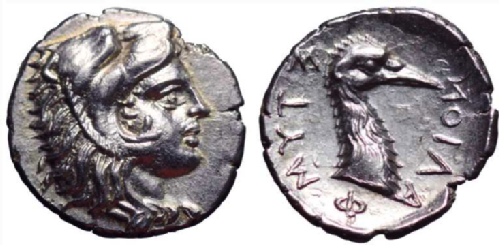 |
| Silver obol of Stymphalos, c. 350 BC, 12mm, 0.95g. |
From Xenophon, we know that citizens of Stymphalos were employed as mercenaries at the end of the fifth century and throughout the fourth century BC. This would account for the presence of foreign coinage at Stymphalos, and would perhaps indicate why so little of the city’s own coinage was in circulation – perhaps it was being carried and traded at other cities across Greece. Coins from neighbouring city mints such as Phlious were found at Stymphalos in larger quantities than the local mint, suggesting that Stymphalos only minted currency when necessary, such as in recovery after an attack. Xenophon dates the attack of Iphikrates to 391 BC, but Schaus gives reason for suggesting that if the attack took place, it more likely would have occurred in 370-369 BC. If we take Schaus’ suggestion, then the timing of the attack would seem a reasonable catalyst for the minting of this coin and other from the mid fourth century BC.
Stymphalos was neighboured by Argos, Corinth and Sikyon within a 30 mile radius, and their prominence overshadowed the city. This coin demonstrates a strong regional identity, with mythology interwoven as part of the historical fabric of the city. Distribution outside the city at the hands of mercenaries allows the iconography of this coin to re-establish Stymphalos’ significance in the mythological history of Greece.
 |
This month's entry was written by Alice Clinch, a Masters student in the department of Classics and Ancient History at Warwick. She has worked on fieldwork projects in Greece and Sicily, and is particularly interested in constructed sacred space and ritual activity in cults.
Bibliography
Imhoof-Blumer, F. and Gardner, P. (1885). Numismatic Commentary on Pausanias. The Journal of Hellenic Studies, 50-101.
Robinson, E. (1901). Report of the Curator of Classical Antiquities. Annual Report for the Year ... (Museum of Fine Arts, Boston), 28-72.
Schaus, G. P. (2014). Stymphalos: Ancient Sources and Early Travellers. In G.-L. e. al., & G. P. Schaus (Ed.), Stymphalos, Volume One: The Acropolis Sanctuary (pp. 6-11). Toronto: University of Toronto Press.
Sturgeon, M. (2014). Sculpture. In Garvie-Lok. et. al., & G. P. Schaus (Ed.), Stymphalos, Volume One: The Acropolis Sanctuary (pp. 36-55). Toronto: University of Toronto Press.
Weir, R. (2007). The Stymphalos Hoard of 1999 and the City's Defenses. American Journal of Numismatics, 9-32.
November 01, 2017
Two Sides of a Coin: Slavery and Religion in the First Servile War

Coin of Eunus (King Antiochus). © The Trustees of the British Museum.
Obverse: Head of Demeter right, veiled with grain-wreath.
Reverse: Ear of grain; ΒΑΣΙ(λέως) upwards on left, ΑΝΤΙΟ(χου) downwards on right.
The late Republic was rocked by three major slave revolts which were unique in their size and extent. The first, and largest, was the First Servile War from c.135 to 132 BC. The extent was such that rebel slaves began to mint coinage and a large portion of eastern and central Sicily was under their control including Enna, Tauromenium, Agrigentum, and possibly Morgantina, Catana, and Syracuse. However, it was a doomed effort and the revolt was finally put down 132 BC as the last cities, Enna and Tauromenium were captured by the consul Publius Rupilius.
 |
| Robinson 1920, 175 |
The revolt began when the slave Eunus led a band of slaves and captured the city of Enna. This city was famous and renowned in antiquity for its cult of Demeter. Cicero stated the people seemed, “not to be citizens of that city, but to be all priests, to be all ministers and officers of Ceres” and when going to the city’s temple one was “going not to a temple of Ceres, but to Ceres herself” (Cicero, Against Verres 2.4.108, 2.4.111). Eunus was then crowned King Antiochus at Enna and minted four issues of coins. These coins are exceptionally rare and only 18 specimens are known. The rarity combined with a poor state of conservation has left the imagery on three of the coins uncertain but local gods and religious imagery are among the possibilities. These coins also included the legend Basileus Antiochou ([coin] of King Antiochus) which advertised Eunus’ newly assumed name and title as well as his legitimacy as King. This month’s coin (with a drawing of the type reproduced here) is the only of these four issues to bear imagery which has been identified with certainty. It depicts Demeter, the goddess of Antiochus’ capital Enna on the obverse with an ear of grain, a symbol associated with the goddess, on the reverse.
The literary sources on Antiochus’ revolt are universally hostile and interpret the role of religion in the revolt differently than what is suggested through the coinage. Instead of Demeter or any of the other local gods which may have been depicted on his coinage, the literary sources emphasize Eunus’ status as a charlatan, a magician, and a follower of the foreign goddess Atargatis which manipulated and deceived his fellow rebels. This served to not only dissociate the revolt from Demeter, the goddess of Enna who was also revered and respected by the Romans, but also to support an account filled with negative slave stereotypes.
Gordon stated, “slave was synonymous with gullible in the Roman mind” [Gordon 1999, 194]. Roman slave owners were specifically warned against allowing slaves to consult fortune tellers, prophets, diviners, and astrologers “who incite ignorant minds through false superstition to spending and then to villanies (flagitia)” (Cato, On Agriculture 5.4).
Antiochus is depicted as exactly the type of fortune teller, prophet, and diviner that Roman slave owners had been warned about.
There was a certain Syrian slave (King Antiochus)… and [he] had an aptitude for magic and the working of wonders. He claimed to foretell the future, by divine command, through dreams, and because of his talent along these lines deceived many. Going on from there he not only gave oracles by means of dreams, but even made a pretense of having waking visions of the gods and of hearing the future from their own lips. Of his many improvisations some by chance turned out true, and since those which failed to do so were left unchallenged, while those that were fulfilled attracted attention, his reputation advanced apace. Finally, through some device, and while in a state of divine possession, he would produce fire and flame from his mouth, and thus rave oracularly about things to come. (Diodorus Siculus 34/35.2.5-9).
Coinage helps to provide a voice for those who do not have their own. The slaves of the revolt have only their coinage to provide their side of the story. This coinage directly contradicts the stereotyped accounts in the literary history and instead depicts a king who represented himself not with a foreign goddess Atargatis but instead with Demeter and traditional iconography.
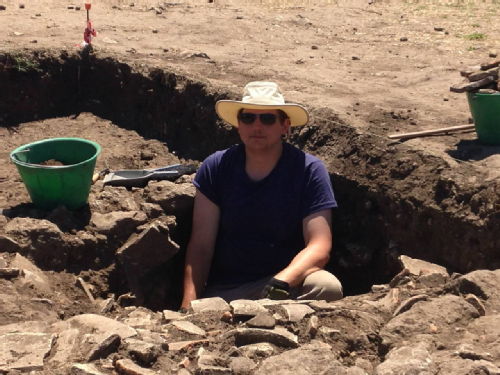 |
This month's coin of the month was written by James Currie. James is a PhD candidate in the department, researching The Transformation of the Sacred Landscape of Republican and Early Imperial Sicily. His research aims to better understand the province of Sicily’s transition from the Republican to early Imperial period through the sacred landscape by investigating the transformation and continuity of “public” religion through the temples and sanctuaries. It also seeks to better understand the province’s political and social changes and how these were both impacted by and influenced the sacred landscape.
Bibliography
Bradley, K. 1989. Slavery and Rebellion in the Roman World 140 BC-70 BC. London: Batsford.
Dickie, M. 2001. Magic and Magicians in the Greco-Roman World. Routledge.
David, E. 2011, "Ein syrisches Sizilien? Seleukidische Aspekte des Ersten Sizilischen Sklavenkriegs und der Herrschaft des Eunus-Antiochos." Polifemo 11: 233–251.
Gordon, R. 1999. "Imagining Greek and Roman Magic". in Ankarloo, B. and Clark, S. (eds) Witchcraft and Magic in Europe: Ancient Greece and Rome. 159-275. London.
Hinz, V. 1998. Der Kult von Demeter und Kore auf Sizilien und der Magna Graecia. Wiesbaden.
Manganaro, G. 1982. “Monete e ghiande inscritte degli schiavi ribelli in Sicilia”. Chiron. 12: 237-244.
Manganaro, G. 1983. “Ancora sulle rivolte servili in Sicilia.” Chiron. 13: 405-409.
Manganaro, G. 1990. "Due studi di numismatica greca". Annali della Scuola Normale Superiore di Pisa. Classe di Lettere e Filosofia 20: 409-27.
McKeown, N. 2012. "Magic, Religion, and the Roman Slave: Resistance, Control and Community". in Hodkinson, S. and Geary, D. (eds) Slaves and Religions in Graeco-Roman Antiquity and Modern Brazil. 279-308. Cambridge.
Morton, P. 2013. “Eunus: The Cowardly King”. Classical Quarterly: 63: 237-252.
Robinson, E.S.G. 1920. “Antiochus, King of Slaves” Numismatic Chronicle 4.20: 175-6.
Sánchez León, M.L. “La amonedación del basileus Antíoco en Sicilia: (Siglo II AC.)” in Chaves Tristán, F and García Fernández, F.J. (eds) Moneta qua scripta: la moneda como soporte de escritura: actas del III Encuentro peninsular de numísmatica antigua, Osuna (Sevilla), Febrero-Marzo 2003. 223-8. Sevilla.
August 01, 2017
The King and the Hybrid

This Coin of the Month is one of the many silver coins of the British King Tasciovanus. He is believed to have ruled an area that approximately corresponds to modern day Hertfordshire towards the end of the 1st century BC. Little is known of his history or circumstances, but he is best known for being the grandfather of Caractacus and Togodumnus, the British kings who fought the Romans during their final invasion of Britain in AD 43.
Tasciovanus was one of the earliest of the British kings to present classical Roman imagery on his coins, with Pegasus, griffons and hippocamps making appearances. The imagery of this coin is part of this trend towards classical imagery, but with one exception: the Capricorn, a beast of the sea, is given the wings of a beast of the air.
Tasciovanus ruled during the reign of Augustus, the first Roman emperor. Augustus used the Capricorn, his star sign, as one of his many symbols. Even without the wings, the Capricorn was already a strange creature, with its front comprised of half of a goat and its rear the back of a fish. Despite this imagery appearing across Rome during the time of Augustus, little is known about the creature’s origins, or its role in ancient myth.
Perhaps it was this mystery that attracted Tasciovanus’ die engravers to the image. Capricorn is never portrayed with wings in the Roman world, so these were a British addition. The inclusion of another element to an already elaborate hybrid was inspired by what is known as Celtic religion. The peoples who inhabited Gaul, modern-day France, and Britain at this time saw their deities not as men and woman, like the Greeks and Romans, but as something beyond the human and natural world, or rather something that stood between them. As a result, the horned god is a popular feature of their mythology, and may explain the prominent horns of the Capricorn on Tasciovanus’ coins. The Tarasque monster, a statue found in France of a terrifying dog like creature, and the elephants with spotted fur depicted on the Gundestrup cauldron from Denmark are another part of this belief. The gods do not walk as men or animal, but as a mixture of the two, or of many beasts, and are nothing like what can be seen with human eyes.
Hybridised creatures of classical mythology, such as the Pegasus or griffon, were attractive images to a culture with such beliefs. The Capricorn was no exception, but perhaps it was not deemed alien enough. The use of wings on the Pegasi and griffons had apparently been pleasing to British audiences, so this might have inspired the addition to the Capricorn here. Adding wings to a sea creature that does not apparently need them makes the monster less natural, and thus more appropriate to the divine forms familiar to the British inhabitants.
The fascination with winged creatures can be witnessed on the many British coin types displaying Pegasus. Rarely used in Roman imagery, the original image may have been taken from the Pegasi shown on coins of Emporion, a Greek colony in Iberia, modern-day Spain. The horse was a powerful image in Celtic art, appearing on coinage and many other forms of material culture, a popularity due to its effectiveness in Celtic warfare, the prestige value of its ownership and possibly the religious rituals associated with the animal. Witnessing a Greek depicting of their venerated animal with the addition of wings would have inspired the Celtic imagination. From then on, the presence of wings on a creature was a popular theme, accounting for the many Celtic coin images of classical monstrosities as well as deities, like the Roman winged goddess Victory.
 |
This month's coin was written by David Swan. David is a postgraduate researcher at the University of Warwick. His thesis examines coinage and hoarding trends along the trade routes of the eastern Atlantic, from the 5th century BC – 1st century AD. He specialises in Celtic coinage.
Bibliography:
J. Creighton, Coins and power in late Iron Age Britain, Cambridge University Press, Cambridge 2000
M. Green, The Gods of the Celts, Alan Sutton, Gloucester 1986
M. Green, An Archaeology of Images: Iconology and cosmology in the Iron Age and Roman Empire, Routledge, London 2004
A. Ross, Pagan Celtic Britain: studies in iconography and tradition, Routledge, London 1967
M. Russell, Bloodline: The Celtic Kings of Roman Britain, Amberley, Stroud 2010
P. Zanker, The power of images in the age of Augustus, University of Michigan Press, Ann Arbor 1988
 Clare Rowan
Clare Rowan

 Please wait - comments are loading
Please wait - comments are loading

 Loading…
Loading…

